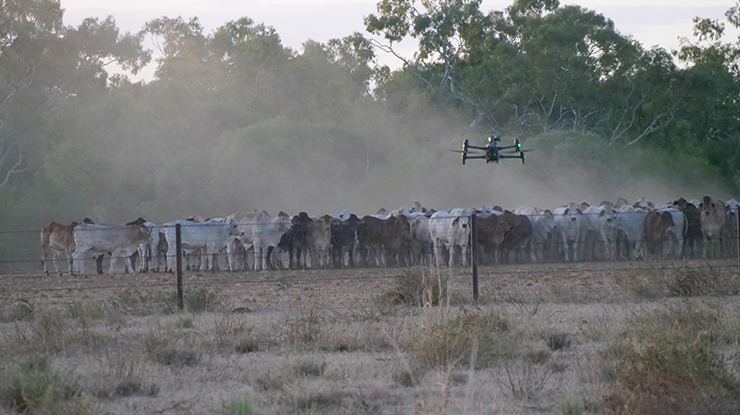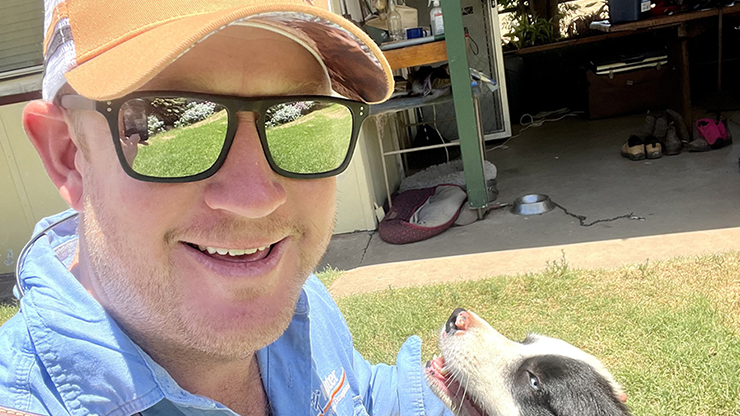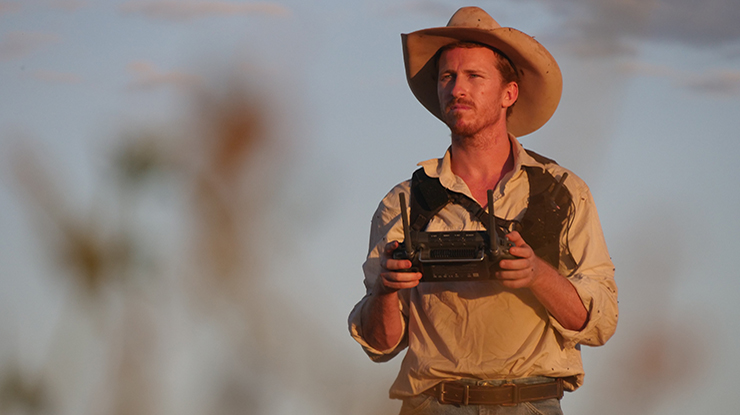 The concept of SkyKelpie has evolved beyond aerial mustering.
The concept of SkyKelpie has evolved beyond aerial mustering.
In the two years since SkyKelpie was founded, drone mustering has reached new heights. With customers representing more than 100,000 head of livestock, the benefits of drone use on-farm continue to be unlocked, far beyond mustering.
On his beef property in Mitchell, Queensland, producer Joe Allen has been using a drone to help with the workload since the early days of SkyKelpie.

Joe Allen was an early adopter of drones to assist on his property near Mitchell, Queensland.
"I went along to a workshop and was instantly convinced," Joe said.
While the main motivation being to help muster the 2,300 head of cattle he runs, Joe soon found himself incorporating the drone into other aspects of the property.
"I've recently upgraded to a drone with a thermal camera, and that has been a game changer."
"Now I use it for feral pest management and control, mustering at night and before the sun comes up, and even finding cattle in the trees."
For Joe, the drone has been a crucial addition to his arsenal of ag-tech.
"Having these tools to work at night, check and control water sources, they're all a way of improving efficiency. I'm not sure about anyone else, but I'm always struggling to find more time," Joe said.
While for million-acre properties there may be no better alternative for helicopter mustering, he found that the drone was more than enough to help across his 25,000-acre property.
"The original purchase is a bit of an outlay, but you more than make your money back, even in the fuel you save from working from the paddock over."
Filling an on-farm need

Luke Chaplain has much more in store for the future of SkyKelpie.
SkyKelpie founder, Luke Chaplain, said what began as a tool for mustering has quickly become one for checking troughs, fence lines, pest management, and even using aerial views to sight in posts.
"Often a producer will tell me something they've done with the drone, and it's something I'd never thought of using it for," Luke said.
Others have used the technology to address the ongoing issue of labour across the industry.
"Some of our clients have been pushed to adopting this technology because they're finding it harder and harder to get labour."
"It's not a perfect substitute and it doesn't help with every task – I wouldn't recommend people do a mass exodus of staff – but the drones have been able to support them with their mustering and other operations."
Depending on a client's business, location and workload, Luke can guide producers to a drone that is best suited to them.
"So much of Australia is rugged terrain, which is pretty hard to get to. Aerial stockmanship has been on the scene since helicopters emerged, so aerial mustering is already a proven solution," Luke said.
As well as accessibility, Luke is an advocate for the safety benefits of the technology, reducing the 'hazard rich' activity that comes with low-level helicopter mustering, and minimising time spent on dangerous terrain.
"If you have a river to cross on a motorbike, not only does that take a lot of time and decrease efficiency, but it's also unsafe."
While there has been positive feedback to the technology, some challenges exist around regulations of flying a drone.
Although being a landholder excludes some producers from needing a license, it means they aren't able to operate the drone beyond their line of sight, limiting how far they can fly it.
For those wanting to work beyond their line of sight, training and an examination is required.
More to come for SkyKelpie
The combined innovation of both the technology and its user has driven Luke to continue building the business in various ways.
"In the next couple of months, we'll be launching some really innovative online training tools, which will be available to people all over Australia."
"With those tools, we're looking to develop a community that helps people with troubleshooting, and where people can share the really cool ideas they've come up with."
During Beef Australia 2024, Luke conducted a SkyKelpie demonstration, using a 'drone in a box', or drone docking station.
"Through this emerging technology, we were able to operate a drone from a completely separate location."
"There was a pilot on the Gold Coast at an approved operations hub, and he was able to operate that drone remotely and push some cattle down a laneway and through a gate in South East Queensland."
"There's a bit of paperwork in it for any producer who wants to be remotely operating their drone, but it's really exciting to see the technology available."






